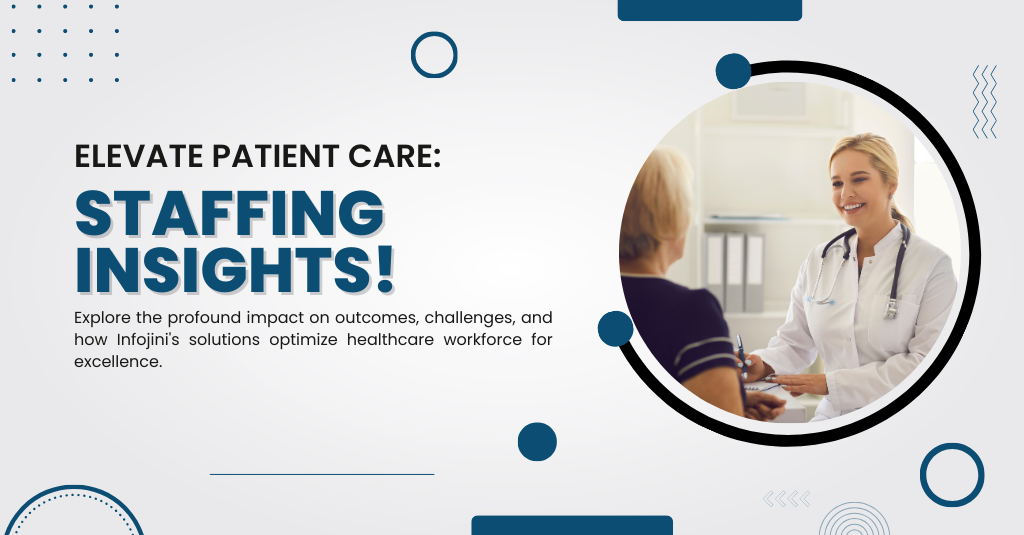Elevating Patient Care: How Staffing Makes a Difference
In the ever-evolving landscape of healthcare, delivering optimal patient care stands as the core objective for institutions worldwide. One often underestimated yet fundamentally crucial aspect influencing the quality of care is staffing. This comprehensive blog aims to delve deeply into the profound impact that staffing has on elevating patient care.
By examining various facets, backed by authentic statistics, and shedding light on how Infojini can play a pivotal role in optimizing healthcare staffing strategies, we aim to provide an in-depth understanding of this critical aspect of the healthcare industry.
Understanding the Significance of Staffing in Healthcare:
Staffing stands as the linchpin in the healthcare sector, acting as the very backbone of any institution devoted to patient care. The quality of patient care is intricately linked to the adequacy of staffing levels, serving as the foundational bedrock upon which healthcare professionals build their capacity to deliver personalized attention, timely interventions, and comprehensive care.
This assertion is fortified by a compelling 2022 report from the American Hospital Association, which illuminates the correlation between higher nurse staffing levels and superior patient outcomes. Hospitals with robust staffing consistently exhibit lower mortality rates and a notable reduction in hospital-acquired infections, underscoring the profound impact of staffing on the overall health outcomes of patients.
Challenges in Healthcare Staffing:
Despite its undeniable significance, the healthcare industry grapples with unique challenges in the realm of staffing. Shortages of qualified personnel, especially in specialized fields, pose a constant threat, straining resources and potentially compromising the quality of patient care. The Bureau of Labor Statistics paints a concerning picture, projecting a 9% growth in demand for registered nurses from 2020 to 2030, exacerbating the existing shortage.
These challenges emphasize the urgent need for healthcare institutions to adopt strategic staffing solutions, ensuring the maintenance and enhancement of patient care quality amidst a dynamic and demanding landscape.
Optimizing Contingent Labor for Patient-Centric Care
Download Now!
The Complex Interplay of Staffing and Patient Outcomes:
The relationship between staffing levels and patient outcomes is intricate and multifaceted. One critical aspect is the profound impact on mortality rates, where research consistently establishes a direct correlation between higher nurse-to-patient ratios and a decrease in mortality. A comprehensive 2021 study published in the Journal of Nursing Administration demonstrated that every additional patient per nurse increased the likelihood of patient mortality by 7%.
Beyond mortality, well-staffed healthcare environments play a pivotal role in mitigating hospital-acquired infections, further highlighting the centrality of staffing in ensuring patient safety and positive health outcomes.
The Ripple Effect on Patient Experience:
Patient experience has evolved into a pivotal metric for evaluating the effectiveness of healthcare services. A 2023 study published in the Journal of Patient Experience delves into the direct correlation between staffing levels and positive patient experiences. Hospitals boasting well-staffed teams consistently report higher patient satisfaction scores, emphasizing the indispensable role staffing plays in shaping the overall perception of healthcare quality.
This ripple effect extends beyond clinical outcomes, influencing the emotional and psychological dimensions of patient care. The holistic impact of staffing on the patient journey underscores its significance in creating a positive and supportive healthcare environment.
Navigating Workforce Challenges with Infojini:
In the face of these formidable challenges, Infojini emerges as a strategic partner for healthcare institutions, offering tailored solutions to optimize their staffing strategies. By leveraging cutting-edge technology, data-driven insights, and industry expertise, Infojini positions itself at the forefront of workforce optimization. The company’s solutions empower healthcare providers to identify staffing gaps, streamline recruitment processes, and cultivate a well-balanced team capable of meeting the diverse needs of patients and adapting to the evolving demands of the industry.
Infojini’s commitment to addressing workforce challenges aligns seamlessly with the goal of enhancing patient care quality, making it a valuable ally for healthcare institutions navigating the complexities of staffing in the modern healthcare landscape.
How Infojini Can Help:
Infojini’s approach to staffing optimization involves a meticulous analysis of current workforce dynamics, identifying areas for improvement, and implementing tailored solutions. By leveraging predictive analytics, Infojini assists healthcare institutions in forecasting staffing needs, mitigating shortages, and ensuring optimal team composition. The integration of artificial intelligence and machine learning algorithms allows Infojini to go beyond traditional staffing models, adapting to the dynamic nature of healthcare and optimizing staff deployment for maximum efficiency.
Ready to Optimize Your Healthcare Staffing?
Book A Meeting Now!
Conclusion:
In conclusion, the symbiotic relationship between staffing and patient care is undeniable. Adequate staffing levels not only contribute to positive patient experiences and improved outcomes but are essential for healthcare excellence. As the healthcare landscape continues to evolve, strategic staffing solutions become imperative.
With Infojini’s expertise in workforce optimization, healthcare institutions can navigate the challenges, ensuring a robust and well-staffed environment that ultimately elevates the standard of patient care. In the pursuit of healthcare excellence, staffing emerges as a linchpin, and Infojini stands ready to guide institutions toward a future of optimized healthcare delivery.
Growing Nursing Shortage: Causes and Solutions
- What are some of the main causes of the nursing shortage in the United States?
- How has the COVID-19 pandemic exacerbated the nursing shortage?
- What role does Infojini play in solving the nursing shortage and supporting healthcare facilities?
Related Posts
Subscribe For Updates
Categories
- Accountant
- AI
- Automation
- Awards and Recognitions
- Blue Collar Staffing
- Burnouts
- Campus Recruiting
- Cloud
- Co-Ops agreements
- Company Culture
- Compliance
- contingent workforce
- Contingent Workforce
- COVID-19
- Cyber Security Staffing
- Data Strategy
- Digital Transformation
- direct sourcing
- Distributed Workforce
- Diversity
- Diversity & Inclusion
- Economy
- Events & Conferences
- fleet industry
- Gig Economy
- Girls in Tech
- Global Talent Research and Staffing
- Government
- Healthcare
- Healthcare Staffing
- Hiring Process
- Hiring Trends
- Home Helathcare
- HR
- HR Practices
- HR Tech
- IT
- Labor Shortages
- Life Science
- Local Governments
- News
- Nursing
- Payroll Staffing
- Public Sectors
- Recruiting
- Remote Work
- Skill Gap
- SMB Hiring
- Snowflake
- Staffing
- Staffing Augmentation
- Staffing Challenges
- Talent ROI
- Tech Staffing
- Technology
- Tips & tricks
- Total Talent Management
- UI/UX Design
- Uncategorized
- Veteran Staffing
- Veterans Hiring
- Veterans Hiring
- Workforce Management
Recent Posts
- Automation in Recruiting: From Chatbots to Predictive Screening
- Gig Economy Expansion: The Impact on Talent Pools and Business Models
- Skills-Based Hiring: Why Credentials Alone Don’t Cut It in 2025
- Procurement 3.0: AI & Intelligent Automation in 2025
- Q3 Is Here: Is Your Contingent Workforce Strategy Falling Behind?
Newsletter
Archive
- September 2025
- August 2025
- June 2025
- April 2025
- March 2025
- December 2024
- November 2024
- October 2024
- September 2024
- August 2024
- July 2024
- June 2024
- May 2024
- April 2024
- March 2024
- February 2024
- January 2024
- December 2023
- November 2023
- October 2023
- September 2023
- August 2023
- July 2023
- June 2023
- May 2023
- April 2023
- March 2023
- February 2023
- December 2022
- November 2022
- October 2022
- September 2022
- August 2022
- July 2022
- June 2022
- November 2021
- October 2021
- September 2021
- August 2021
- July 2021
- June 2021
- May 2021
- April 2021
- March 2021
- February 2021
- January 2021
- December 2020
- November 2020
- October 2020
- September 2020
- August 2020
- July 2020
- June 2020
- May 2020
- April 2020
- March 2020
- February 2020
- January 2020
- December 2019
- November 2019
- October 2019
- September 2019
- August 2019
- July 2019
- June 2019
- May 2019
- January 2019
- December 2018
- November 2018
- October 2018
- September 2018
- August 2018
- July 2018
- June 2018
- May 2018
- April 2018
- March 2018
- February 2018
- January 2018
- December 2017
- November 2017
- October 2017
- September 2017
- August 2017
- July 2017
- June 2017
- May 2017
- November 2016
- October 2016




